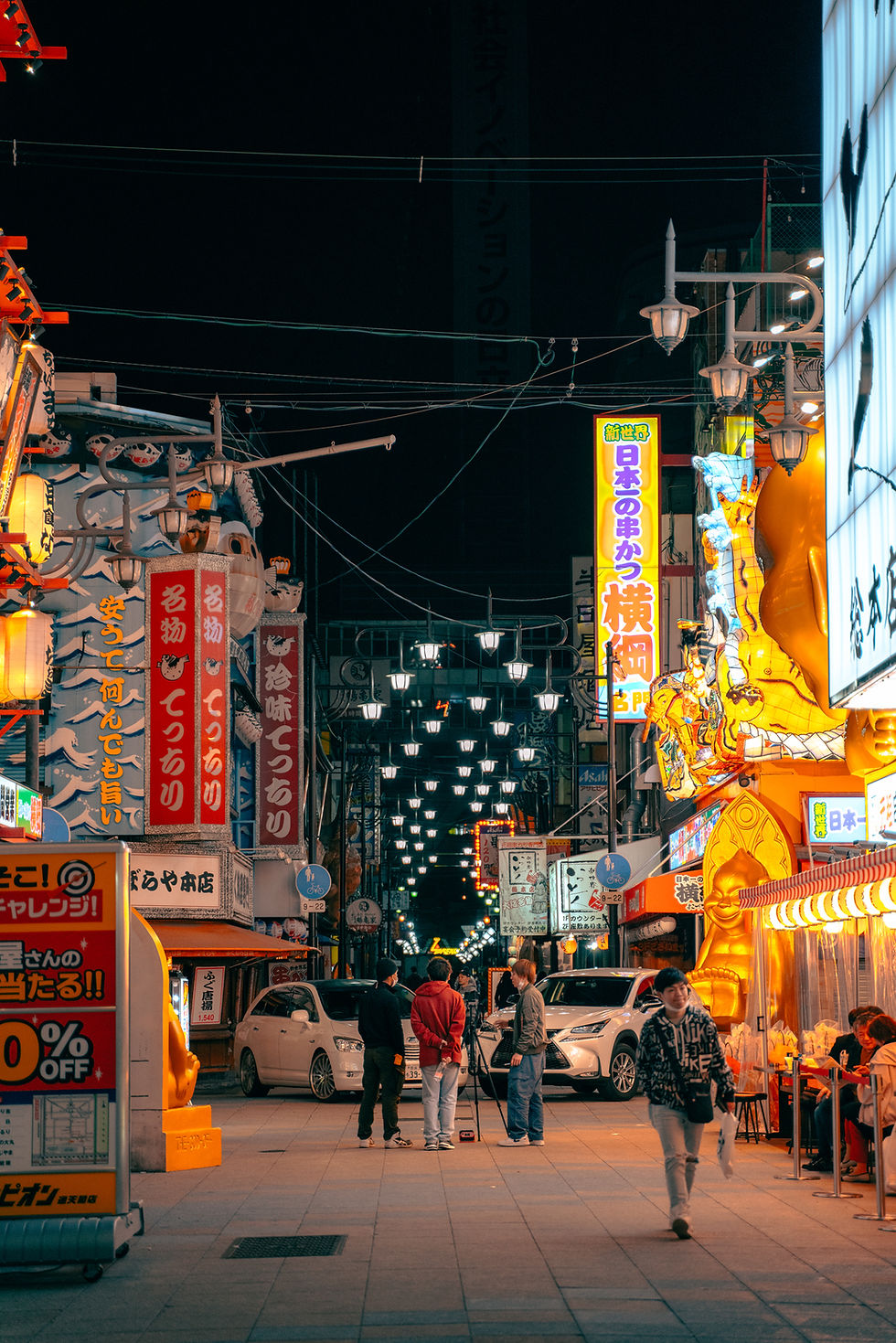Nakagin Capsule Tower
- Rei Tsuru
- Mar 6, 2023
- 7 min read

Nakagin Capsule Tower was a strange-looking tower near Shimbashi and Shiodome stations. Two rust-colored pillars with parallelepiped capsules attached to them, steel tentacles with giant suction cups cutting through the asphalt, a hundred-eyed monster staring up at the skyscrapers of Shiodome.
I first saw it just surfing on the Internet, in a a low-resolution picture from the '70s a few years ago, and something ticked inside me, and I told myself that I had to find this house. Closer to another (second, I guess?) trip to Japan, the house got a little forgotten, but my ex-husband and I found it by accident while walking from Ginza to... I don't remember, toward Odaiba. I remember noticing the familiar outline from the photo, rushing toward it and being confronted by a sign that read "NO TRESPASSING", threatening severe punishment to anyone who dared open the heavy door. Nakagin was no longer the snow-white building pictured above. It was draped in gray construction netting and smudged in time-darkened capsules, and looked more like a ghost in rags. I didn't want to leave. And for several years I came there, and I didn't want to leave. I remember it.
I remember living there. I don't even want to try to debate and argue about the number of lives and the possibility of rebirth, I just remember things that are nowhere to be found, not in any picture, not in any video, not anywhere that you can find online. I remember the dawn in the round window, the smell of the sun-heated air, the sharp black outlines of the cars on the bridge, the crumpled bed after sleep, some other elusive little things, like the jars in the bathroom and the yellow sign on the road to the house. I remember the atmosphere, rather than specific things — the air in the capsule room when you open the door during the day, the sounds of the elevator, the noise outside the window.
It may sound funny, or silly, but it's actually sad. I miss a life I barely remember. I remember what color my hair was, but I don't remember what I did. I think Nakagin holds the memories of everyone who lived there, and if I get into that capsule of mine, I'll remember or learn something very important. When you hug one of its pillars, you can feel the life flowing inside that thing with a deafening clang. I can hear it, and the sound is like the humming that space objects make.

Do you want to hear about the white rabbit?
It all started when in a difficult period of my life (the red pill chose me) I started to be haunted by the theme music from The Matrix (Clubbed to Death), then the girl (her name is really Alice, hey Alice, I love you) with the rabbit tattoo found me and took me to her team…

About five years ago, I spent the spring in Tokyo, living, going to language school, and making new friends. My departure was on Easter, and my mother gave me three rabbits she had knitted, a blue, a yellow, and a white one to give to my friends. The blue one stayed with my Ksu, the yellow one with Aoda's family, and I forgot about the white one which stayed in my suitcase until I left. So the day before my flight to Moscow, I put it in my backpack in case I ran into some friends, and just wandered around Tokyo. I didn't meet anyone, and I didn't really want to. I remember that I just lounged in the shadows for a while on the Shiodome glass bridge, and then I went down to Nakagin's, had another mental conversation with him about something, and just dropped the rabbit off at some flyer stand in the entryway. And left. I left to walk in the sunset shallows on Odaiba, while the rabbit looked frightenedly after me.
Then there was the plane and Moscow.

I returned to Japan a year later, and then my brother came to visit me briefly, and Tokyo opened its arms to him with joy and hospitality. After a few happy days, Ars and I and a few friends decided to give him a sort of farewell dinner, and before that we took a walk, and my Japanese fairy godmother suggested we go see Nakagin — they had never seen it, and I hadn't been there since I arrived, because it all made me very
uneasy. And so, we approached the closed doors, and a perky friend dives inside, I followed her. She's a guide and journalist who knows how to persuade, and she starts messing with the guard's head that we would really like to have at least one look at this architectural marvel from inside, the guard apologizes and offers to contact the real estate agency, maybe they will agree to show one of the capsules, and I turn my head and see the same rack that was outside last year, and there sits my rabbit...
The guard smiles and says that they found the rabbit that year and moved it inside as their mascot. "Well, you used to live here, and now he..."
In 2020 we went back to the Nakagin, found out from the guard that he still can't let us in, but he did let us take a couple of pictures on the first floor.

The case was helped by the otherwise sad situation of the pandemic. Tourists had practically disappeared from Tokyo, and I found out that it was possible to book an individual tour to Nakagin for 4 people maximum. Also not a cheap story, but I really needed to, so I made an appointment with a guide, and there were only three of us - me, our guide Yuki and my friend who may not be as interested in Nakagin itself, but is interested in everything new, and I am very grateful for his company.

And here we are, inside. Only one capsule on the 9th floor is open for tours; of course they don't let you run around the tower, but you can look around quite freely. From the stairwell you can go out to... I don't know, a balcony or something. Large ledges on the windows are for protection from prying eyes.
Designed by Kisho Kurokawa and built in 1972, Nakagin stands as the quintessential model of Japanese metabolism to this day, representing the architectural style that epitomizes Japan's resurgence in the post-war era. The capsules that make up the tower were initially intended for use as living spaces and offices, and for a period, the building thrived. However, over time, the occupants deserted the structure, leading to a proposal to demolish it in 2007, citing the impracticality and unreliability of the design.

This building had a certain amount of fans and we tried to save it by drawing attention to it as an architectural heritage, doing reports and publishing books, but all to no avail, and demolition began in the spring of 2022.

By that time the war had already started, my departure for Japan was a few months away, and I could only follow on Instagram how another capsule was being removed from the building.

The gap between the two towers. The Nakagin really does look abandoned compared to most Japanese houses, and you want to hug it, wash it, and fix it up. The renovation program should have been started a long time ago, at least in the 90s.
I can't say I have any strong flashbacks, I just felt like I was back home, where I hadn't been away that long, except that the house had become very dilapidated for some reason.
The capsule is inside. There should still be a bed behind me, but it was removed to make it more convenient to take sightseers here. The proceeds helped Nakagin to survive at that time.

These capsules are equipped with the latest technology of the 1970s and are fully autonomous: it was supposed that in case of wear they can be removed, replaced with new ones, and simply swapped places as needed, but since the construction there has been no such replacement.

This is not the capsule I probably lived in, based on the view I remember it was located just below and looking out the window in the other direction. And I remember this bridge with no houses nearby.
Bathroom. At that time there were already big water problems in the building, because the pipes could not be replaced.

Yes, it's small, but you can see how ergonomic and thoughtful this space is, and pay attention to the wide sides, where you can put all the necessary accessories even if there are no shelves. The overhanging sink is a great example of space saving, by the way.

I think the turntable and the alarm clock still work, there's nothing to break in a pretty primitive piece of machinery from almost 50 years ago

We start climbing the shelves and find a Lego tower model.
The windows used to have special cylindrical blinds attached to the center, but now only the same construction mesh obscures the view.

There were some interesting books in the capsule, in particular Kisho Kurokawa's album, in which you can find a rather detailed description of the Nakagin Tower, and, yes, that four-sided scheme of his, which looks like a shuriken, which would be nice for a T-shirt print. Here you can see how white and fresh it was.

A floor-by-floor diagram of the location of the capsules. Of course, you can't be sure, but mine was probably on the 7th floor, Tower A. Capsule 7-6 is looking just the right way. Maybe 7-5, too.

Kurokawa has many fascinating works, such as one of the pavilions for Expo-70 in Osaka.
For me I t clearly refers to the works of Giger and the style of the first Alien by Ridley Scot
Nakagin used to stand proudly in the middle of the wasteland by the road, and then it became cluttered with houses so that the round windows were only visible from behind their walls when you came very close. Once huge and snow-white, it now seems small and alien.
My heart sank every time I turned down this street

We walked down to the 7th floor, and there's the shabby electric panel.
Some of the capsules looked quite bad, but when I was inside, I didn’t feel the atmosphere of decay. Maybe it's my memories were making it so alive.

And that might have been my capsule. Someone lived there, and it looked neater than most. In fact, that's one of the reasons why only residents were allowed in here - it's quite a good audibility and its own fragile ecosystem.
When I returned to Japan in 2022, the building, hidden behind white construction panels, was almost completely demolished.
Those capsules that are subject to restoration, it was decided to send to architectural museums around the world.

There are a few books about Nakagin. In 2020, together we raised funds to release this book which you can buy online or in Tokyo bookstores.

Making a donation from Russia was not easy, thanks to the guy in the capsule in the photo on the left, the talented architecture student from Ukraine who lived in that capsule for a few years and helped me organize it. My copy of the book waited for me only 2 years later, when Volodya and I finally met on the very bridge near Siodome station, where you could see Nakagin so well before.
At least my name remained here.







































Comments